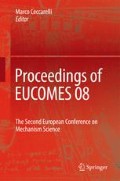Abstract
Proteins play an essential role in biochemical processes. Recently, a new viewpoint has arisen within protein researches, based on the parallelisms between proteins and mechanism. In this paper the authors present a new approach to obtain protein motion paths based in computational kinematic considerations. Finally, simulation results for an specific protein are presented.
Access this chapter
Tax calculation will be finalised at checkout
Purchases are for personal use only
Preview
Unable to display preview. Download preview PDF.
References
Arthur Lesk. Introduction to Protein Science. Oxford University Press, 2006.
Tamar Schlick. Molecular Modeling and Simulation. Springer, 2006.
Kazem Kazerounian, Khalid Laif, and Carlos Alvarado. Protofold: A succesive kinetostatic compliance method for protein conformation prediction. Journal of Mechanism Design, 127:712–717, 2005.
Sean Cahill, Michael Cahill, and Kevin Cahill. On the kinematics of protein folding. Journal of Computational Chemistry, 24:1364–1370, 2003.
Rachel Kolodny, Leonidas Guibas, Michael Levitt, and Patrice Koehl. Inverse kinematics in biology: The protein loop closure problem. International Journal of Robotics Research, 24:151–163, 2005.
Kazem Kazerounian. From mechanism and robotics to protein conformation and drug design. Journal of Mechanism Design, 126:40–45, 2004.
Linus Pauling and Robert B. Corey. Atomic coordinates and structure factors for two helical configurations of polypeptide chains. Proceedings of the National Academi of Sciences, 37, 1951.
Protein Data Bank.PDB.http://www.wwpdb.org/index.html.
Eric W. Weisstein. Roation formula. MathWorld-A Walfram Web Resource, http://mathworld. wolfram.com/RoationFormula.html.
V. Petuya, J.M. Gutierrez, A. Alonso, O. Altuzarra, and A. Hernandez. A numerical procedure to solve non-linear kinematic problems in spatial mechanisms. International Journal for Numerical Methods in Engineering, 73:825–843, 2008.
Author information
Authors and Affiliations
Editor information
Editors and Affiliations
Rights and permissions
Copyright information
© 2009 Springer Science+Business Media B.V.
About this paper
Cite this paper
Diez, M., Petuya, V., Urízar, M., Hernández, A. (2009). A Kinematic Approach to Calculate Protein Motion Paths. In: Ceccarelli, M. (eds) Proceedings of EUCOMES 08. Springer, Dordrecht. https://doi.org/10.1007/978-1-4020-8915-2_9
Download citation
DOI: https://doi.org/10.1007/978-1-4020-8915-2_9
Publisher Name: Springer, Dordrecht
Print ISBN: 978-1-4020-8914-5
Online ISBN: 978-1-4020-8915-2
eBook Packages: EngineeringEngineering (R0)

